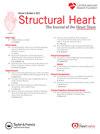经导管主动脉瓣置换术后主动脉瓣和左心室流出道钙分布和传导结果:系统回顾和荟萃分析
IF 1.4
Q3 CARDIAC & CARDIOVASCULAR SYSTEMS
引用次数: 0
摘要
永久性起搏器植入术是经导管主动脉瓣置换术(TAVR)后的重要并发症。瓣下钙及其在主动脉小叶间的分布对TAVR术后PPMI风险的影响尚不清楚。我们对主动脉瓣复合体(AVC)的小叶钙、左心室流出道(LVOT)的小叶钙、总AVC钙、总LVOT钙和二尖瓣环钙及其与tavr后房室传导阻滞、左束支传导阻滞和新PPMI的关系进行了系统回顾。搜索策略包括5个数据库,确定893篇文章。定性分析共纳入34项研究,共纳入11528例患者;定量分析共纳入7项研究,共纳入1056例患者。在荟萃分析中,左冠状动脉尖钙和右冠状动脉尖钙是PPMI的显著预测因子,而非冠状动脉尖(NCC)钙无预测作用(左冠状动脉尖:平均差值:21.05 mm3, 95% CI: 5.92-36.19, p <;0.001;右冠状动脉尖:平均差值46.02 mm3, 95% CI: 1.84 ~ 90.21, p = 0.04, NCC:平均差值0.19 mm3, 95% CI: - 0.32 ~ 0.50, p = 0.10)。在定性回顾中,NCC区域的LVOT钙是最常预测tavr后传导结果的小叶。总AVC、总LVOT钙和二尖瓣环钙与tavr后传导结果没有令人信服的关联。与tavr后传导异常有关的是钙的分布,而不是其总体积。研究方法和植入技术的异质性限制了这些发现的临床意义。本文章由计算机程序翻译,如有差异,请以英文原文为准。
Aortic Valve and Left Ventricular Outflow Tract Calcium Distribution and Conduction Outcomes After Transcatheter Aortic Valve Replacement: A Systematic Review and Meta-Analysis
Permanent pacemaker implantation (PPMI) is an important complication following transcatheter aortic valve replacement (TAVR). The influence of valvular and subvalvular calcium and its distribution between aortic leaflets on the risk of PPMI following TAVR remains unclear. We performed a systematic review of the aortic valve complex (AVC) calcium by leaflet, left ventricular outflow tract (LVOT) calcium by leaflet, total AVC calcium, total LVOT calcium, and mitral annular calcium and its association with post-TAVR atrioventricular block, left bundle branch block, and new PPMI. The search strategy included five databases identifying 893 articles. A total of 34 studies with 11,528 patients were included for qualitative analysis, and seven studies totaling 1056 patients were suitable for quantitative analysis. On meta-analysis, left coronary cusp calcium and right coronary cusp calcium were significant predictors of PPMI, while noncoronary cusp (NCC) calcium was not predictive (left coronary cusp: mean difference: 21.05 mm3, 95% CI: 5.92-36.19, p < 0.001; right coronary cusp: mean difference: 46.02 mm3, 95% CI: 1.84-90.21, p = 0.04, and NCC: mean difference: 0.19 mm3, 95% CI: −0.32 to 0.50, p = 0.10). On qualitative review, LVOT calcium in the NCC region was the leaflet most commonly predictive of post-TAVR conduction outcomes. Total AVC, total LVOT calcium, and mitral annular calcium had no convincing association with post-TAVR conduction outcomes. The distribution of calcium rather than its total volume was associated with post-TAVR conduction abnormalities. Heterogeneity in methodology and implantation techniques between studies limits the clinical significance of these findings.
求助全文
通过发布文献求助,成功后即可免费获取论文全文。
去求助
来源期刊

Structural Heart
Medicine-Cardiology and Cardiovascular Medicine
CiteScore
1.60
自引率
0.00%
发文量
81
 求助内容:
求助内容: 应助结果提醒方式:
应助结果提醒方式:


